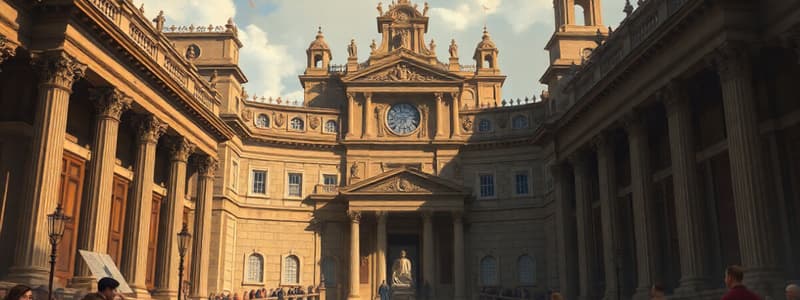Podcast
Questions and Answers
What was the primary function of supreme courts during the early modern period?
What was the primary function of supreme courts during the early modern period?
- To serve solely as advisory bodies to the monarch.
- To establish legal authority, and maintain order. (correct)
- To manage local elections and community affairs.
- To oversee public works and economic development.
From which segment of society were the judges of early modern supreme courts typically drawn?
From which segment of society were the judges of early modern supreme courts typically drawn?
- From the elite and educated classes. (correct)
- From rural peasants and agrarian workers.
- From local merchants and craft guilds
- From the ranks of the military and clergy.
Which of these was NOT a key function of the Senato of Milan?
Which of these was NOT a key function of the Senato of Milan?
- Managing petitions submitted by the public.
- Enforcing royal decrees and maintaining order.
- Administering local elections and community affairs. (correct)
- Resolving legal disputes between individuals and groups
What is meant by the term 'preces' in the context of the Senato of Milan?
What is meant by the term 'preces' in the context of the Senato of Milan?
What primary purpose did petitions serve in the legal system of early modern Europe?
What primary purpose did petitions serve in the legal system of early modern Europe?
How did Supreme Courts contribute to centralization of power in early modern Europe?
How did Supreme Courts contribute to centralization of power in early modern Europe?
Which of the following was a characteristic shared by supreme courts across early modern Europe?
Which of the following was a characteristic shared by supreme courts across early modern Europe?
What role did the decisions of supreme courts like the Senato of Milan play in the governance of their regions?
What role did the decisions of supreme courts like the Senato of Milan play in the governance of their regions?
Flashcards
What were the key roles of Supreme Courts in early modern Europe?
What were the key roles of Supreme Courts in early modern Europe?
Supreme courts emerged as central institutions of justice during the early modern period, embodying the power of sovereigns while establishing legal authority and maintaining order. These courts reflected the consolidation of centralized states and were critical in addressing disputes, interpreting laws, and upholding sovereign authority.
Who were the judges in Supreme Courts?
Who were the judges in Supreme Courts?
Professional judges staffed supreme courts, often drawn from the elite and educated classes. These judges were experts in legal science and played a decisive role in legal interpretation and decision-making.
How did supreme courts relate to royal authority?
How did supreme courts relate to royal authority?
Supreme courts served as instruments of royal power, reflecting the monarch's role as the ultimate guarantor of justice.
What was the Senato of Milan?
What was the Senato of Milan?
Signup and view all the flashcards
What were Preces?
What were Preces?
Signup and view all the flashcards
What were the common features of Supreme Courts across Europe?
What were the common features of Supreme Courts across Europe?
Signup and view all the flashcards
How did petitions provide access to justice?
How did petitions provide access to justice?
Signup and view all the flashcards
Study Notes
Supreme Courts in Early Modern Europe
- Supreme courts emerged as central justice institutions in the early modern era, reflecting the centralization of power and the need to ensure order.
- They wielded judicial and, often, administrative authority, resolving disputes and upholding sovereign power.
Professional Judges
- Supreme courts were staffed by expert judges, often from the elite.
- Judges were crucial for legal interpretation and decision-making.
Royal Authority and Supreme Courts
- Supreme courts served as instruments of royal power, strengthening the monarch's position.
- The monarch was seen as the ultimate guarantor of justice.
Senato of Milan: A Key Example
- The Senato of Milan was a prominent supreme court in early modern Europe, under Spanish Habsburg rule.
- It held both judicial and administrative functions within its jurisdiction.
- It handled disputes, managed petitions, and enforced royal decrees.
- This demonstrated the court's dual role of dispensing justice and governing.
Petitions and the Senato of Milan
- Petitions ("preces") were vital to the Senato's operations.
- Individuals or communities used petitions to appeal to the court directly, which bypassed lower courts.
- Petitions were diverse, ranging from requests for legal remedies to appeals for compassion.
- Petitions offer insight into the relationship between subjects and the sovereign.
Characteristics of European Supreme Courts
- Early modern supreme courts across Europe showed commonalities.
- They centralized judicial authority, diminishing influence of local courts and customary laws.
- These courts were the apex of judicial systems, overseeing lower courts to ensure uniform legal interpretation.
- Examples include the Parlement of Paris, the House of Lords, and the Reichskammergericht.
Access to Justice Through Petitions
- Petitions were significant pathways to justice.
- Subjects could appeal directly to supreme courts through these petitions, bypassing other courts.
- Judges possessed considerable discretion during petition processing, highlighting the flexibility of the system.
- Petitions showed the active role of citizens in seeking legal remedies for their grievances.
Studying That Suits You
Use AI to generate personalized quizzes and flashcards to suit your learning preferences.




